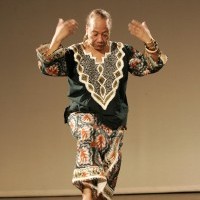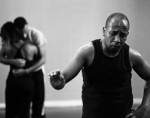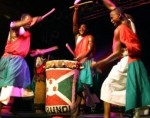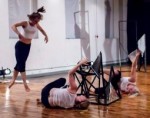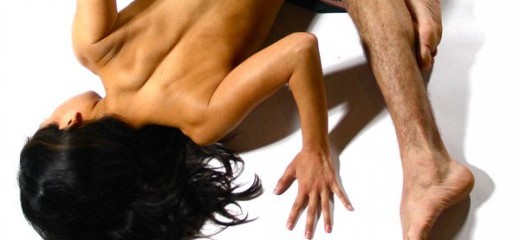
Photo: Lindsay Browning
Public Spaces, Personal Places
by Kariamu Welsh
Last night’s preview of idiosynCrazy productions’
Private Places began before the doors officially opened. We were greeted by two dancers who commanded us in loud monotone voices to follow them to seats in designated groups. In the rectangle space, the chairs stood back to back in sets of two. The seating of audience members was a performance in itself, with dancers on the floor in various stages of movement. It was an effective segue to the main event, as everyone, including the viewers, had become part of the choreography already.
Seven dancers plus choreographer, Jumatatu Poe, clad in steel gray costumes with black harnesses, worked the Live Arts Studio in intricate and intimate ways that ignored the audience’s need for personal space. I could “smell” the dancers as they moved around and through us. “Smelling” the dancers felt like being in the dance studio when things become up-close and personal.
Initially, I did a lot of twisting, turning and shifting in my chair to see what was behind me. This action engaged us audience members as we tried to see everything. We had to think about our role in accommodating the performers as the space was tight and the dancers had made it clear that the gaps between chairs belonged to them as well. We had to tuck our legs underneath when we turned in our chairs; we made sure that our legs weren’t obstructing the aisles. The whole room belonged to the dancers, including – we would soon learn — our very own seats that we were starting to become attached to!
The militaristic stance of the dancers was a common mantra throughout the performance. Its early introduction clued us in to J’Sette, a dance form that sprung from marching bands at historically black colleges and universities in the South. Gay men expanded and stylized the movements and created a vehicle for expression that is vibrant, rhythmic and dynamic. Poe abstracted both the essence and movement vocabulary of this Southern dance phenomenon. He and his dancers skillfully “worked” the dynamics of hip rotations and pelvic thrusts in unexpected ways that didn’t go where one would expect. Several times, the dancers held their arms straight up in the air as they rotated in a staccato turn and then paused. This movement kept the integrity of the “militaristic” affect, while it unified the dancers and audience in moments of clarity and definition. The result was a muted and nuanced movement language that Poe used to address the complexity of identity. J’Sette was a reference point for Poe but it did not dominate the work.
Throughout the performance, the dancers vocalized sounds that were at times primal cries and screams, at other times laughs and recognizable words. Verbal instructions were given to each other and audience members. We were told to “stand up” and to “sit down.” The function of these exercises became clearer as later on in the performance, audience members were instructed to leave their seats and sit on assigned seats along the wall. Eventually, the space was (re)envisioned with audience members seated on the periphery of the room allowing for a large open space that was clear of chairs.
As the performance unfolded, the dancers were in various stages of undressing. This was done in a fairly unobtrusive way as the dancers writhed on the floor or threw almonds on the stage in diagonal and square patterns. The initial costumes were pared down to purple and lime colored midriff tops for the six women and short briefs for the two men. The music was an intense metronome for much of the performance but it was interrupted a few times by techno beats that brought the dancers together in fast, furious and propulsive choreography. The dancers began their final stage of undress as they huddled in an amorphous mass. The nudity was gradual and uneventful. By “uneventful,” I mean that Poe was able to pace the performance so that when the nudity occurred, it did not shock. The dancers seemed comfortable in the nude: at one moment they walked up to and stood right in front of audience as if to confront any anticipated “discomfort.”
At the end of the 75-minute piece the dancers brought out large pieces of plastic and put them on the floor. Two dancers stood on the tarps as the others poured oil and then a blood-like substance over their bodies, before wrapping the two in the plastic as if to “seal” the matter.
Private Places was a provocative, multilayered and intense experience with a diverse aesthetic palette that titillateed and numbed, sometimes simultaneously.
Private Places idiosynCrazy productions, Sept. 15, 18 and 20 at 8pm, Sept. 16 at 4pm and Sept. 19 at 9pm, 18-20, 919 N 5th St.
Mini-Ball
We Just Gon’ Buck, Sept. 14, 7-10pm, Church of the Advocate, 1801 West Diamond Street.
Privatizing and Publicizing Gender: An Intimate Dialogue into Private Places, Sept. 15 at 3pm, Live Arts Studio, 919 North 5th Street.
http://livearts-fringe.ticketleap.com/private-places/
By Kariamu Welsh (1949-2021)
September 14, 2012


